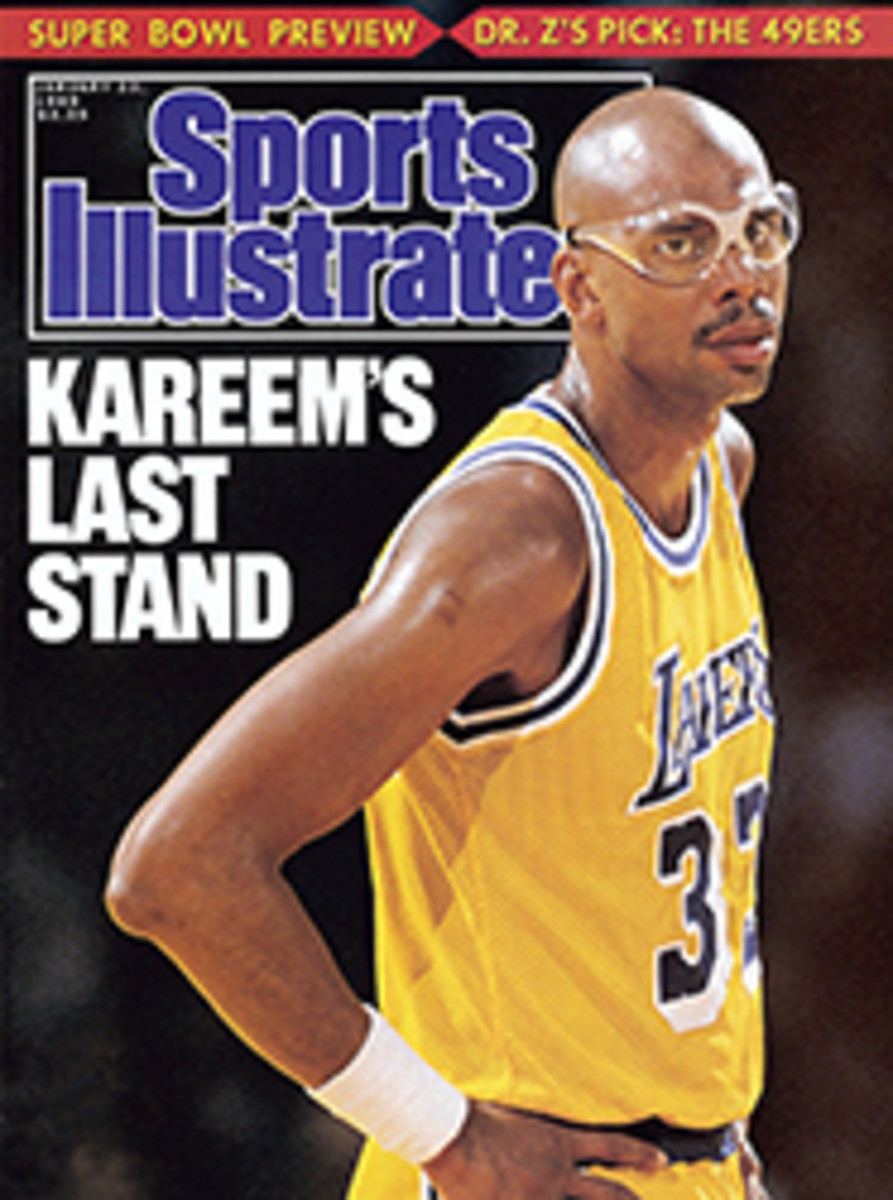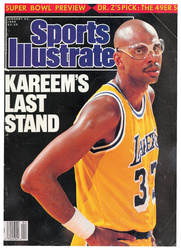
A NEW PROPOSITION
It's still early, but so far the most important score of the college basketball season has been 163-154, the margin by which delegates to the NCAA convention in San Francisco last week passed a proposal to stiffen rules governing the awarding of athletic scholarships. When the measure, known as Proposition 42, was approved on a second ballot (after having been voted down only a day earlier), it touched off a fire storm of criticism, mostly from coaches who stand to lose the services of youngsters whose academic prowess has not kept pace with their athletic skills.
The most publicized protest of all took place last Saturday at the Capital Centre in Landover, Md. Just before the opening tip of Georgetown's game against Boston College, Hoya coach John Thompson took his signature white towel off his shoulder and draped it over that of assistant Mike Riley. Thompson then strode off the floor while the crowd of 15,379 gave him a standing ovation. He would not say how long his boycott would last, but if his team missed him on this night, it wasn't immediately apparent: Georgetown went on to win 86-60.
Even those who might have regarded Thompson's gesture as little more than a grandstand play could not ignore it—or the issue that precipitated it. The controversy really began six years ago, when delegates to that year's NCAA convention, concerned about widespread academic abuses involving college athletes, passed Proposition 48. It was a landmark piece of legislation that eventually became codified as NCAA Bylaw 5-1-(j). Beginning in 1986, the rule stipulated, entering freshmen would be eligible for scholarships only if they had achieved a grade point average of at least 2.0 in a college-preparatory core curriculum and, when it came to the two standard college entrance examinations, attained a minimum score of 700 on the Scholastic Aptitude Test (SAT) or 15 on the American College Testing Program's exam.
The standards were minimal, yet some educators and athletic officials felt that Proposition 48—as it's still generally known—discriminated against underprivileged students, particularly minorities. Only one black was among the 37 university presidents who framed the legislation, and representatives of predominantly black schools were incensed by the weight given to the standardized tests, which have been widely and persuasively attacked as culturally biased in favor of white, middle-class youngsters.
Partly to defuse that criticism, the delegates at that 1983 convention created a loophole of sorts for athletes who met at least some of the Proposition 48 requirements. These players could enroll in a university and receive full financial aid, but they could not play or practice with the team as freshmen. These partial qualifiers would then have only three years of varsity eligibility instead of four—provided they made their grades in their first year. Ever since, colleges have been living, however uneasily at times, with that arrangement, which was intended to make athletes hit the books harder in high school.
The passage of Proposition 42 stirred emotions anew by, in effect, eliminating the partial-qualifier loophole. Beginning in August 1990, schools may tender athletic scholarships only to incoming freshmen who meet all the requirements of Proposition 48. This means that non-qualifiers would have to pay their own way as freshmen, which many can't afford to do, or go to junior college, which would leave them with as few as two years of eligibility at a four-year school.
Proposition 42 was sponsored by the Southeastern Conference, whose interest in the proposal may have been a little self-serving, since it already had passed its own legislation barring partial qualifiers from receiving financial aid beginning in 1993. But University of Mississippi athletic director Warner Alford denies that the SEC acted to avoid finding itself at a competitive disadvantage. "There have been partial qualifiers out there who said, 'I can still get a scholarship even if I don't measure up,' " says Alford. "Now we simply will see those students working harder to qualify—and that's the intent."
But some people involved in college sports, including Temple basketball coach John Chaney (box, page 18), see more sinister motives in the passage of Proposition 42. At the extreme, they charge the NCAA with racism—at a time when enrollment of all black males at colleges and universities is declining—and insensitivity to the underprivileged. Says LSU basketball coach Dale Brown, ''Many of the people who voted for this proposal would have to look up the word ghetto in the dictionary, because they've never been there."
Yet most athletic officials, even those who oppose it, regard Prop 42 as a well-intentioned effort to strike a balance between academic integrity and the need to provide an opportunity for the disadvantaged athlete who wants a degree and is willing to work hard to get it—a kid like John Thompson was as a high school senior in Washington, D.C. Thompson says he could not have gone to college under Prop 42, but he's careful not to paint Proposition 42 in racial terms. "It's not solely a black-and-white issue," he says. "I'm making a statement for low-income athletes."
Coaches said that they were surprised by the passage of Proposition 42. If anything, they were hoping for changes that would have benefited partial qualifiers, such as letting them practice during their year on the sidelines and granting them an extra year of eligibility if their academic record proved to be satisfactory. Said coach Lou Henson of Illinois, "How long was this Proposition 42 studied? It sounds like something passed in a few minutes in a committee room."
Indeed, a valid criticism of the vote is that the convention should not have toughened Proposition 48 without having had a chance to fully scrutinize its effects. Has it made high school athletes study harder? Has it discriminated against blacks and the poor? After all, roughly 1,800 athletes have lost a year's eligibility to Proposition 48 to date, and 86% of the football and basketball players have been black. Does this prove that the entrance exams are culturally biased? And why have most of the Prop 48 casualties become eligible as sophomores? Is it because a lot of kids are pulling themselves up by their academic bootstraps? Or because of tutors provided by big-time athletic departments? Or do coaches conveniently find ways, and courses, that make eligibility a certainty? "Anything this controversial should have been tabled and investigated more thoroughly," says Colorado football coach Bill McCartney.
The coaches' protests would be more convincing if, as a group, they had a better record when it comes to academics. Many still seem more concerned with circumventing the rules than abiding by them, and one argument against Prop 42 is that it would encourage even more cheating. Says Pittsburgh basketball coach Paul Evans, "Not only will it lead to more cheating on the SAT and ACT scores, but you'll have cheating by boosters who will pay for the [nonqualifiers'] first year of school." Adds Fresno State basketball coach Ron Adams, "If a kid can't pay his own way, who's going to? His family? I doubt it."
Peter Dalis, athletic director at UCLA, suggests that the universities that have shied away from partial qualifiers—his school, Stanford and Notre Dame, among others—may break off from the NCAA and play among themselves. Says Wyoming basketball coach Benny Dees, "This [Prop 42] is going to hurt some of us, but it's O.K. if you're North Carolina, Indiana or Virginia. They don't know what the hell's going on with this because they don't deal with these kids. They don't recruit them. Sure, I'd love to have a team full of kids who get a 4.0 and don't need study halls and whose eligibility I don't have to ever worry about. But it doesn't happen that way, and I just don't think you can take those other kids and throw them away."
With the enormous sums of money at stake in major college sports, it's unlikely that anyone with basketball or football talent will be thrown away. Gifted athletes will always be provided for. As Southwest Conference commissioner Fred Jacoby says of those who will be affected by Proposition 42, "You're not really depriving them, you're just sort of steering them onto a different route for the first two years." Indeed, the coaches will find a way to make do, and it can only be hoped that the solutions are within the NCAA rules.
One possibility is that schools will assist athletes in securing government loans and grants. However, Prop 42 will go into effect at a time when federal financial aid for education is drying up; there will be fewer dollars for deserving, underprivileged youngsters who have excelled in the classroom, much less for academically marginal athletes.
Junior college would seem to be a logical choice for Prop 42 casualties, just as it has been for many of the athletes who ran afoul of Prop 48. In the jucos, athletes can prepare themselves academically while retaining athletic eligibility. But the Division I—caliber players may end up squeezing out juco players who have no other options. And Prop 42 will hurt private schools more than public ones, considering the difference in cost. Says Miami football coach Jimmy Johnson, "In state-supported schools, where the tuition is small, the coaches can sign these players and have them walk on, pay their own way and then qualify and not lose any eligibility."
All the protests notwithstanding, it's heartening to see universities, through their support of Prop 42, paying more than lip service to the term student-athlete. The business of universities, after all, is education, and, as Indiana basketball coach Bob Knight, a defender of the new measure, says, "The thing they [opponents of Prop 42] need to understand is that college isn't for everybody."
Indeed, as the NCAA moves to strengthen its academic standards, perhaps it also should end its hypocritical understanding with the NFL, by which players aren't eligible to be drafted until their college class graduates. That might force the NFL to follow the lead of the NBA, by taking some players earlier, and of organized baseball, by establishing farm systems for those athletes who now attend college only to major in becoming a professional.
Of course, there is the possibility that Proposition 42 may not survive beyond next year's NCAA convention. Thompson's protest walk may have been the first step toward overturning the legislation. Says Syracuse coach Jim Boeheim, "Because John did this, I guarantee the next time [Prop 42] comes up, it won't pass." Boeheim might be right. As anybody in college athletics knows, a 163-154 victory isn't exactly a blowout.
PHOTO
GEORGE TIEDEMANN
When Thompson (center) took a hike, Hoya players and fans applauded the gesture.
PHOTO
PETER READ MILLER
TWO BENEFICIARIES: Notre Dame quarterback Tony Rice and Michigan guard Rumeal Robinson sat out a year under Proposition 48 but got scholarships that would be prohibited under the new rule.
PHOTO
JOHN W. MCDONOUGH
[See caption above.]

